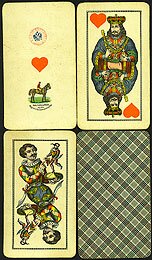|
"Short-Card" was the common name given to card games like: 3-card Brag, Monte, Bluff and Whiskey. These games were not popular with
most professional gamblers as they considered the games play to slow.
 Many professional card players had to rely on more than simply luck to assure that their time spent at the tables Many professional card players had to rely on more than simply luck to assure that their time spent at the tables
produced a profit. They would practice for hours in an attempt to master the art of cheating. Known as "Sharps",
they could handle a deck of cards as skillfully as a surgeon with his scalpel. He could adeptly false cut and shuffle,
palm, stack, second and bottom deal even when his opponents were watching his every move. In addition to being
skilled at "working the cards" the professional gambler also knew where he could purchase cards that were marked,
stripped, trimmed, sanded, daubed, waxed, and treated. Not to mention that many could perform his own "special work".
If you want a true picture of what the Old West life and gambling was all about find a DVD of the HBO series,
"Deadwood". It just doesn't get any closer to the truth then Deadwood.
The earliest mention of Poker is in the book, "An Exposure of the Arts and Miseries of Gambling", published by G. B.
Zieber in Philadelphia 1843. This book again published by T. P. Peterson, Philadelphia 1857.
Peterson also published, "The Reformed Gambler or the History of the Later Years of Jonathan H. Green", in 1843.
Draw Poker was introduced about the time of the Civil War. Per, " Foster's Practical Poker", 1905, Straights and Straight Flushes
were of "NO" value in Stud Poker since the games was invented prior to anyone recognizing the importance of either.
 Playing cards came to America with the Pilgrims. They were made from pasteboard, a ridged material Playing cards came to America with the Pilgrims. They were made from pasteboard, a ridged material
that would easily bend and tear. The corners were squared and the backs were plain. By the mid 1850's
those backs were painted and just before the 1870's indexes were added (numbers in the corners). The
earliest example of double-ended cards dates to 1861 but didn't take root until the 1870's. And, no known
rounded-corners have been found prior to 1875.
Joker's were introduced in the 1870's. Initially called the "Best Bower", then the "Jolly Joker" and finally
"Joker", they were used as an extra card if a card in the deck was lost or damaged. Joker's were eventually
used as a Wild Card.

|